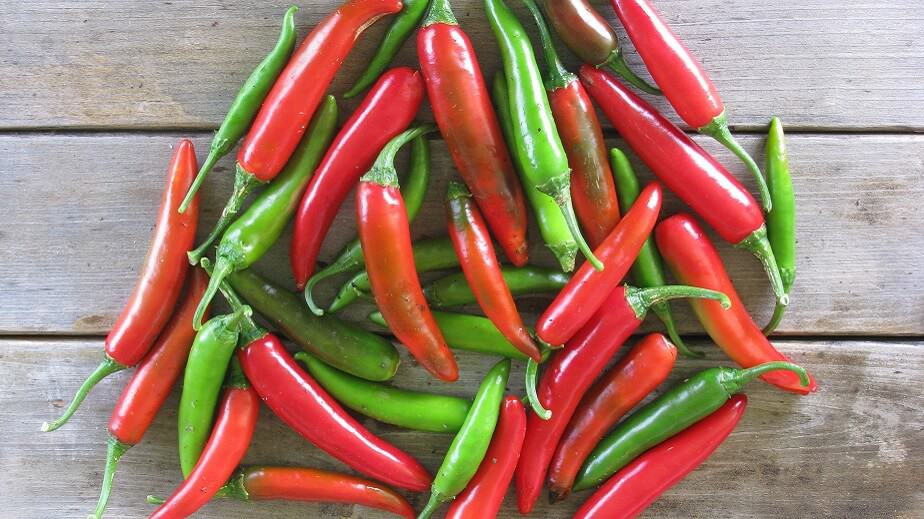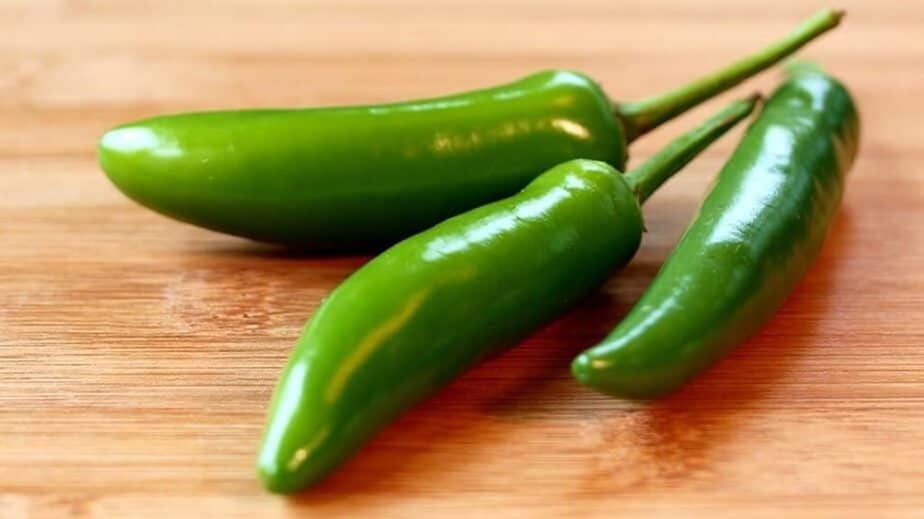What Are Serrano Peppers?
The serrano pepper is one type of chili pepper that mostly grows in the mountainous regions of Puebla and Hidalgo in Mexico. The name ‘serrano’ is actually a reference to the mountains, influenced by the Spanish word “sierra’ which means ‘mountain’. It’s a small and moderately hot chili pepper.
They are torpedo-shaped and typically no longer than 3-4 inches. Something special about their appearance is the rainbow colors, according to the level of ripening colors vary from green to yellow, orange, red, and even brown.
Key Facts In A Gist
- Capsicum species: Annuum
- Origin: Puebla and Hidalgo, Mexico
- Harvest: 70 to 85 days after planting
- Heat level: 10,000 to 23,000 SHU
- Median heat: 13,000 SHU
- Size: average 3-4 inches long and ½ inch diameter
- Shape: tapered, slender
- Color: ripen from green to red, yellow, or orange
- Flavor: earthy, grassy
- Uses: flavoring foods, condiments
- How to Use: roasted, pan-cooked, fresh garnish, or as dry powder spice
- Best Substitutes: jalapeno, cayenne pepper, crushed red pepper
Serrano Pepper Scoville
Serrano peppers are classified under mild hot chilies with their Scoville heat units ranging between 10,000 and 23,000. They have an ideal level of heat for general cooking. However, even this heat level may be spicy for some who aren’t habituated to eating spicier chili peppers.
Serranos are up to nine times hotter than their cousin, the jalapeño with 2,500 to 8,000 Scoville heat units.
If you compare serrano with cayenne, this chili is a few notches down in spiciness. Serranos are two to five times milder than cayenne pepper (30,000 to 50,000 Scoville heat units).
Serranos can no way be a competitor to Habanero peppers which have a heat level anywhere between 100,000 and 350,000 SHU. Roughly, serranos are 3 to 35 times milder than habanero peppers.
What Do Serrano Peppers Taste Like?
Generally, the flavor of fresh serrano chili is bright and grassy with a robust heat. Dried or roasted serrano pepper tastes earthy and smoky with vibrant heat.
Usually, smaller and mature serranos tend to produce more heat but unripe or green peppers are mild. Nipping into a serrano pepper will give you a spicy kick like the jalapeno.
What Are Serrano Peppers Good for?
Serrano pepper is widely used in Mexican cooking. Often, it’s eaten raw, used in salsas, relishes, and garnishes; cooked up in spicy recipes, or pickled. With a sharp flavor and fiery heat, they are useful in making hot sauces and dips.
Removing the seeds and a peel of the inner flesh of this chili can reduce the intensity of heat. Caution, some might experience a harsh burning sensation on the skin and irritation in the eyes if proper protection gears are not used while handling serrano peppers.
Health Benefits of Serrano Pepper
Most hot peppers have health benefits galore, and serrano peppers are no exception. By including them in your food you have a few good health benefits to achieve besides enjoying their flavorful heat and wonderful flavor.
Relieves Pain: Studies show that capsaicin in hot peppers is useful for inhibiting inflammation caused by conditions like arthritis, tendinitis, and muscle strain from injury. Today, capsaicin is a key ingredient in many OTC pain reliever topical creams, patches, or oral rinses.
Prevents Some Types Of Cancer: A few recent studies suggest that capsaicin may protect against the development of breast, pancreatic, bone, and colon cancer to some extent.
Improves Cardiovascular Health: Capsaicin is expected to reduce bad cholesterol and increase good cholesterol. Recent research suggests that capsaicin helps to reduce cholesterol absorption in the intestine and increases cholesterol excretion.
Regulates Blood Sugar: According to a few study reports, capsaicin supplements have been shown to reduce high blood sugar levels and reduce the overproduction of insulin in women with gestational diabetes.

Frequently Asked Questions
What are the differences between serrano and jalapeno peppers?
With a ranking of 10,000 to 23,000 Scoville Units on the Scoville Scale, serranos can be up to nine times hotter than Jalapeno. Serranos taste grassier and a bit sharper because of the higher heat levels.
How hot is a serrano pepper?
Serrano peppers are hot and spicy, literally. The average heat of serrano remains around 13,000 SHU which falls in the upper range of mild peppers. However, serranos at their peak heat level are equal to low medium hot peppers.
What does a serrano pepper look like?
Serranos are long and thin, similar to a smaller version of jalapeno peppers. They generally grow between 1-4 inches long and about 1/2 inch wide and are tapered to a pointed tail-end. They take different colors like green, yellow, orange, or red, changing color as they ripen. The plant grows about five feet tall and produces up to 50 peppers at a time.
When to pick serrano peppers?
The best time to pick serranos is when they are about to change color from green to yellow, red, or orange. Once the color is changed, soon they fall off the plant or can even rot on the plant. Green serranos are sweet but hotter when ripened. After planting the seedlings, they are usually ready to be harvested in about 70 to 85 days.
Read Next: Poblano Peppers
